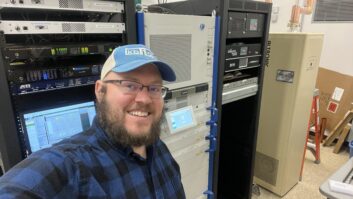Recently I was tapped to engineer a live interview by American Public Media’s “Weekend America” in the snowy reaches of Camden, Maine. Nothing special? Well, it was made a little more interesting by the location: a ski slope next to a frozen lake with no AC power, no telco landlines and no wireless Internet. Plus, it had to be done live.
American Public Media wanted to cover the U.S. National Tobogganing Championships and sent freelance writer Keith O’Brien to report on the competition. So how’d we do it? ISDN over satellite.
Now as you might imagine, there are about 1,000 things that can go wrong with such a scheme … and go wrong they did. But with foresight, planning, backups, testing, more backups, more testing and yet more backups, we kept it a comedy instead of a tragedy.
A few days before the event, my mailman delivered a Thrane & Thrane M4 TT-3080A portable satellite telephone with folding dish (www.globalcoms.com/products_satellite_thrane.asp), and a Telos Zephyr Xstream ISDN, with built-in mic mixer, in another (www.telos-systems.com/). The Thrane satellite phone folds into a portable and lightweight package that is carried easily in a backpack.
Test runs
Our first test was from my apartment in Boston. I had a narrow — very narrow — view of the sky from my back porch, just enough for one little bar of signal from the Inmarsat AORW floating over the western Atlantic Ocean region. That’s enough to get the ISDN to dial, and lock on one end; but not both.
After much fiddling with the satellite dish I discovered you must aim the dish precisely, but you’ll get four or five bars of signal as a reward, and a happy ISDN. The AAC-LD (low delay) codec sounded remarkably good over our 64 kbps channel.
So the telco problem was solved. Now we needed to deal with a lack of power. This proved to be tricky. A standard little “brick” UPS such as the APC ES250 ought to provide enough power for our needs, and a stress test confirmed about 25 minutes of power. I decided a second, comparable UPS was a good idea. Going further, I wanted a “belt and suspenders” approach with a DC to AC inverter charging a UPS, and then the gear running off the UPS.
I assembled my gear, rented my car and headed off from Boston the night before the show. Unfortunately, Murphy hopped a ride too. The season’s first real snowstorm blew through that evening, turning a four-hour drive into six hours.
Late that evening, I arrived at the toboggan chute, found an ideal spot and set up for another test run. There was a freezing rain/snow mix steadily falling, and not all this gear is weatherproof. Fortunately, I’d brought a five-foot-wide patio umbrella with me and clamped it to the trunk lid.
After getting another successful test done, I retired to my hotel room. I repacked all the gear with an eye towards carrying it by hand if I couldn’t get my preferred spot. All batteries were topped off and I nodded off for the evening, hoping the weather would clear.
Fortune smiled upon us, as the day arrived with beautiful clear skies, a fresh layer of ice on the chute and plunging temperatures. Good thing I’d packed extra sweaters and long underwear. Unfortunately, one of my UPSs suddenly wasn’t holding a charge. Thankfully, we had a spare UPS. And as it turns out, despite valid concerns about an inverter’s “square wave” causing audible noise on the ISDN, there wasn’t any noise during our last-chance morning test and we ran on the inverter alone.
Soon after, a dogsled team with ten noisy, barking huskies set up shop not 20 feet from us. A little chat with the owners and they said it would be no problem to take the dogs on a run across the lake when we were live. The by-then-faint barking actually worked great from an ambient sound perspective.
The morning’s test on the satellite phone had drained the satellite phone’s battery alarmingly fast. (Perhaps the battery was too cold?) Even worse, we suddenly learned that running the satphone’s charger off the inverter caused too much electrical “noise.” The ISDN wouldn’t lock any more. Fortunately, we had a spare battery in the warm car; a quick swap and we re-established the ISDN link. But even the warm battery was quickly running out of juice. Suddenly this 15-minute connection looked mighty tenuous.
Both Keith and I have cell phones with Verizon service — no wireless interference to our audio gear. We quickly dialed Keith’s cell phone into the “Weekend America” studios and patched it in to its mix board so we had a hot-standby ready to go. I set up Keith and his interviewee, tobogganer Andy Hazen, with ElectroVoice RE50B mics with hefty windscreens, and Sony 7506 headphones.
As 12:30 rolled around, we were feeling a little nervous, but nonetheless hopeful. Host Bill Radke introduced Keith and we were off. The background noise of dogs, snowmobiles and PA announcements set the scene perfectly. Keith shared his toboggan run story, Andy shared his secret toboggan wax formula of “moose drool” — and I nervously watched the satphone’s battery indicator steadily drop and the satphone start to beep softly.
Fervent wishful thinking on my part ensured the satphone battery held in there just long enough to finish the interview. I later learned that data calls on the satphone drain the batteries fast, but they still should have lasted around 20 minutes or so. Our batteries must’ve been old; they were dying after barely 10.
Be prepared
The point here is that pretty much everything that could go wrong, did. Even comically so. For instance, my polarized sunglasses — ideal for snow glare — made reading the LCD displays very difficult. Fortunately we tested extensively and had time to prepare backups.
As it happened, the one thing we didn’t test to real-world conditions was the one thing we were nearly bitten by: the battery life of the satphone. Admittedly, we thought we were covered with a spare battery and a charger, but the one thing for which we had two layers of backup needed three. The moral is, always do a complete test, just as if it were the real thing.
As a side note, I’m not sure I’d recommend ISDN over satellite for doing remote interviews. It has several points of failure and is quite expensive. But at the same time, when you’re away from the comforts of home it’s nice to know you can have ISDN-quality sound if you need it. And admittedly, I got to have a fun trip to Maine and watch guys hurtle down a chute on an old couch. Ain’t public radio grand?
Listen to the piece atwww.weekendamerica.orgin the Feb. 3, 2007 archive.












